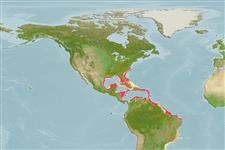Environment: milieu / climate zone / depth range / distribution range
Ecology
Marine; demersal; depth range 8 - 73 m (Ref. 93147). Tropical
Western Atlantic: eastern Gulf of Mexico, southern Florida in USA to northern South America.
Size / Weight / Age
Maturity: Lm ? range ? - ? cm
Max length : 10.0 cm TL male/unsexed; (Ref. 7251)
Dorsal
spines
(total): 7;
Dorsal
soft rays
(total): 12-13;
Anal
spines: 1;
Anal
soft rays: 11 - 13. Distinguished by the following characteristics: eye diameter 7.7-10% SL; typically, D I,12 and A I,12; D1 spines not distinctly elongate; first and D2 fins with 3-5 brown or tan horizontal stripes; upper lip lightly pigmented to pale, absence of a dark stripe above upper lip; pelvic disk lightly pigmented to pale; 4-5 dark brown blotches along lateral midline of the body; blotches often connected by slightly lighter horizontal band of pigment along lateral midline; longitudinal papillae row b originating at vertical through anterior margin of pupil (Ref. 93147); laterally compressed head and body; large mouth and very oblique; completely scaled body with ctenoid scales; first dorsal with VII spines; pelvic fins fused forming a disc; caudal fin lanceolate (Ref. 92840).
Inhabits offshore waters (Ref. 7251), over mud or sand-mud bottoms (Ref. 13628); flat areas with fine sediment near coral reefs (Ref. 93147).
Life cycle and mating behavior
Maturity | Reproduction | Spawning | Eggs | Fecundity | Larvae
Van Tassell, J.L., L. Tornabene and P.L. Colin, 2012. Review of the western Atlantic species of Bollmannia (Teleostei: Gobiidae: Gobiosomatini) with the description of a new allied genus and species. aqua, Int. J. Ichthyol. 18(2):61-94. (Ref. 93147)
IUCN Red List Status (Ref. 130435)
Threat to humans
Harmless
Human uses
Aquarium: commercial
More information
ReferencesAquacultureAquaculture profileStrainsGeneticsElectrophoresesHeritabilityDiseasesProcessingNutrientsMass conversion
Tools
Warning: mysqli::__construct(): (HY000/1040): Too many connections in /var/www/html/includes/speciessummary.lib.php on line 2414
Can't connect to MySQL database fbquizv2. Errorcode: Too many connections
